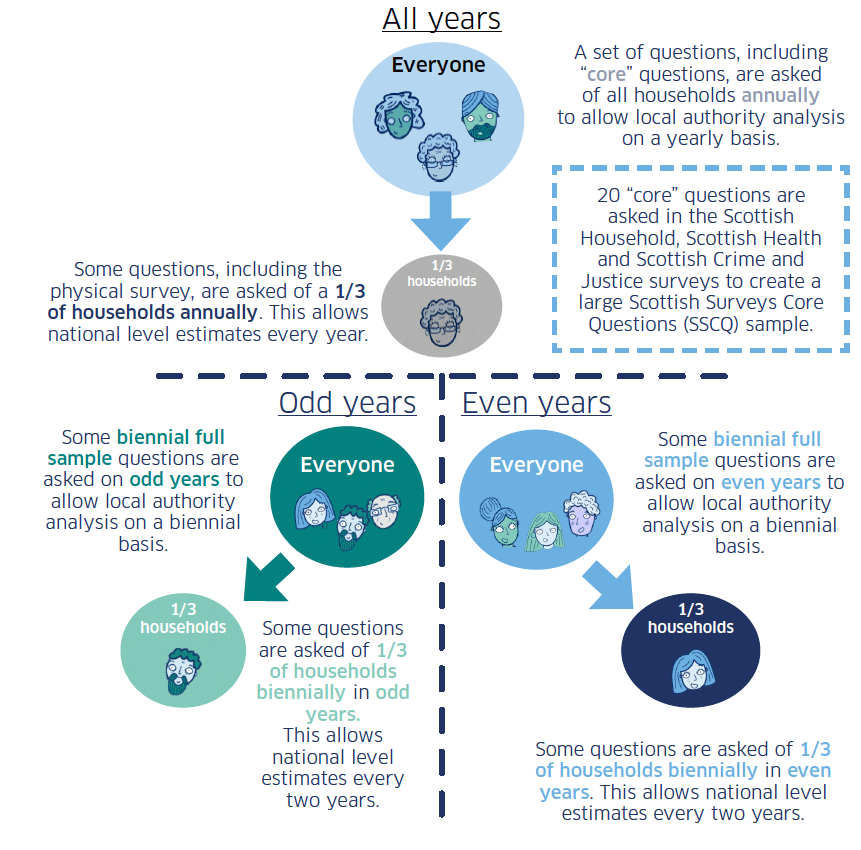Scottish household survey 2018: key findings
Key findings from the Scottish household survey 2018: annual report.
Introduction to the survey
The Scottish Household Survey (SHS) is a continuous survey based on a random sample of the general population in private residences in Scotland.
Questions are asked face-to-face by interviewers in homes all over Scotland.
Participation is voluntary, but it is important in helping us make representative estimates for Scotland.
Each home selected to take part receives an advance letter and leaflet in the post explaining that an interviewer from Ipsos MORI will call.
The survey started in 1999 and is essentially three surveys in one:
Transport and Travel in Scotland (TATIS), the Scottish House Condition Survey (SHCS) and the SHS. It covers a wide range of topics to allow links to be made between different policy areas.
About a third of households are randomly selected to take part in the SHCS, which normally takes place shortly after the interview at a convenient time selected by the householder. This non-intrusive survey is completed by a qualified surveyor who will assess the condition and energy efficiency of the selected homes.
The SHS is a unique chance for people in Scotland to tell about their views and experiences on a range of issues, helping to shape each local area and Scotland as a whole. Since its beginning, it has helped shape various public services over time.
At national and local level, analysis of SHS data is used to identify which people or areas need funding most, including for transport and housing.
For example, Scottish Government analysis of SHS data identified lower internet access for those living in social housing. Until then it had been thought that access to the internet was lowest for those who rented from private landlords. Knowing the facts meant that funding could be correctly targeted at social housing tenants in order to provide affordable broadband access and training.
The Scottish Household Survey report is produced under the Code of Practice for Official Statistics.
National Statistics are produced free of political interference, to agreed standards, and undergo regular quality assurance reviews. For more information, visit https://www.statisticsauthority.gov.uk/publication/code-of-practice/
Introduction to the survey: Uses
Scotland’s largest random pre-selected survey, the SHS, is at the centre of Scotland’s evidence based approach to policy-making.
The survey provides robust evidence on the composition, characteristics, attitudes and behaviour of private households and individuals as well as evidence on the physical condition of Scotland’s homes.
The current scale of the SHS enables all users to obtain a robust deeper understanding of issues and performance, by being able to analyse across key demographic household characteristics such as: deprivation, age, income, gender and rurality. This is crucial to informing the Fairer Scotland agenda.
Some of the ways in which SHS evidence is used:
Housing data is used to determine the size of the Private Rented Sector in Scotland and is a crucial element of National Records of Scotland (NRS) Household Projections, which local authorities use in their Housing Plans. Affordable Housing Funding is allocated using historic NRS household estimates.
Data is used for key performance monitoring frameworks, including: 12 Scotland Performance Indicators, half of the Housing & Regeneration Outcome Indicators, over half of the Active Scotland Outcome Indicators, and over a quarter of the Child Poverty Measurement Framework Indicators.
The SHS is the only source of Fuel Poverty evidence and the only nationally representative source of data on energy efficiency, house conditions and quality. This is used extensively in the design, targeting and funding allocations for SG energy efficiency programmes (SEEP).
The Travel Diary component of the SHS is a unique data source on personal travel patterns, which underpins analysis of future transport needs and economic business cases for national and local transport infrastructure investment projects.
Transport and Housing Energy Efficiency data are crucial for monitoring carbon emissions, informing Climate Change policies and progress.
All local authorities in Scotland use the data in their Single Outcome Agreements.
The Improvement Service use the data for the Local Government Benchmarking Framework to understand and improve local needs and circumstances.
There is particular interest in SHS local data on communities, local services, neighbourhoods, volunteering, recycling and access to outdoors and greenspace.
The SHS collects and publishes a wide array of information, a list of key resources can be found here.
Introduction to the survey: Design
The survey has been designed so that there is a balance between building a useful evidence base and making sure that the interview is not a burden for respondents. Careful consideration is given to how many households should be asked each question, and how often.

64 per cent of people chosen agreed to take part in the survey
10,530 households participated in the household section of the interview
(Target sample size was 10,450)
9,700 adults participated in the random adult section of the interview
For further technical information, including how response rate is calculated, see the Fieldwork and Outcomes report
Contact
Email: shs@gov.scot
There is a problem
Thanks for your feedback